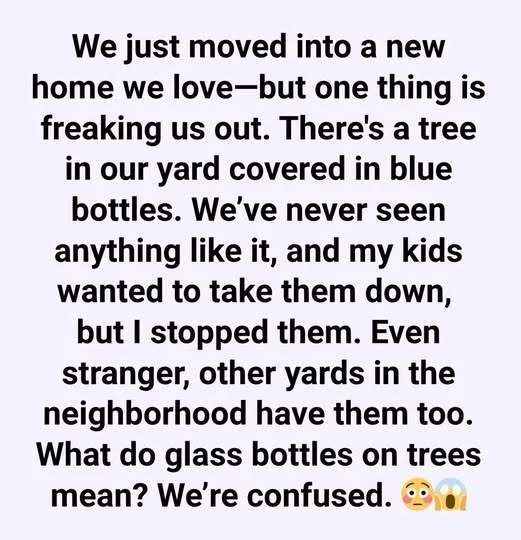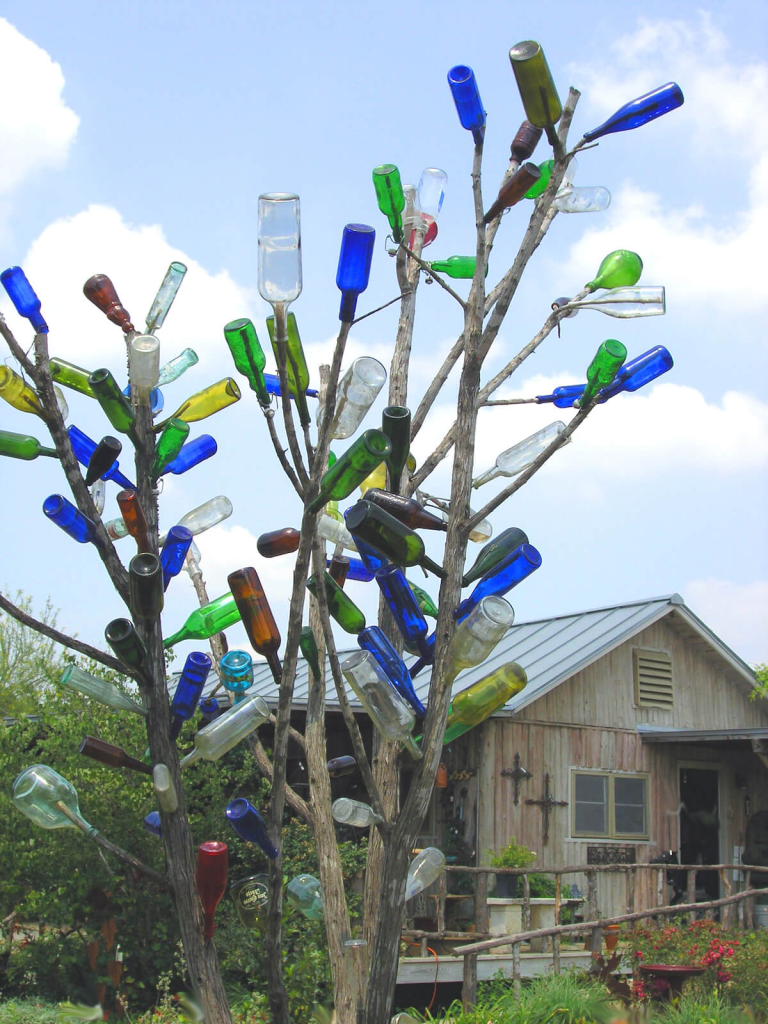You’ve probably seen one—an odd but beautiful tree with vibrant glass bottles hanging from its bare branches, glinting in the sun like some kind of magical art installation. At first glance, it looks whimsical. Maybe even like a quirky garden project. But look a little deeper, and you’ll discover that bottle trees are not just decoration—they’re spiritual guardians, cultural time capsules, and living prayers rooted in centuries of resilience.

From Central Africa to the American South: A Journey of Spirit and Survival
Bottle trees didn’t begin as backyard art. Their story traces back to the Congo and surrounding parts of Central Africa, where communities believed reflective objects—especially colored glass—could ward off evil spirits. The idea was simple but powerful: spirits are attracted to bright colors and shiny things. Once drawn in, they’d get trapped inside the bottles.
When enslaved Africans were brought to the American South, they carried these beliefs with them. Stripped of nearly everything, they held tight to the spiritual practices that still gave them meaning, identity, and a sense of protection. The bottle tree was one of those practices—and it took root in American soil as both a spiritual shield and a quiet form of cultural resistance.
Video: The Magical Bottle Tree Forest
The Power in the Bottles: Not Just for Show
There’s symbolism behind the sparkle. Each bottle, carefully placed on a tree, served a purpose. Blue bottles, for example, were often used for their association with protection and peace. Some believe that the spirits would become trapped inside, especially if the bottle was upside down or tilted. As the sun heated the glass, the spirits would be sealed in. And that eerie whistle you might hear when the wind passes through? That’s not just wind—it’s said to be the spirits crying out, caught and contained.
It might sound like folklore, but for many, this wasn’t superstition—it was sacred. Bottle trees were placed near homes, porches, gardens, and even gravesites. They were meant to guard families, remember the ancestors, and create a boundary between the seen and the unseen.
Every Bottle Tells a Story

What’s especially moving about bottle trees is that they’re often built using found glass—bottles that once held medicine, tonic, wine, or oil. These weren’t picked for aesthetics. They had meaning. A green bottle might’ve come from a grandmother’s remedy. A clear one could’ve been used at a family celebration. Once placed on the tree, the bottle transformed from object to offering.
Each piece became a memory. A tribute. A way of saying: You are not forgotten. You are still with us.
A Tradition Still Standing Today
Though rooted in African heritage, bottle trees have since crossed cultural boundaries. Today, you’ll see them in backyards across the South, in desert gardens, even in suburban neighborhoods. But for many African American families—especially those with deep Southern roots—the bottle tree remains a sacred link to the past.
It’s not about trend or aesthetic. It’s about honor. About keeping something alive in a world that tried to erase it. And in that shimmering display of light and glass is a message that still echoes: There is more to life than what meets the eye.
Respecting the Roots of the Tradition
Video: Bottle trees evoke spirits of ‘forgotten souls,’ artist says
As bottle trees grow in popularity, it’s important to remember where they came from. These trees are more than craft projects. They’re part of a spiritual tradition born from pain, survival, and the strength to hold on to something meaningful in the face of unspeakable hardship.
To truly appreciate a bottle tree is to honor the stories it holds. To recognize the people who built them as a way to claim peace, power, and presence in a world that denied them all three.
So next time you pass one, slow down. Let yourself take it in.
Feel the sun on the glass. Listen to the breeze sliding through the bottles. Know that what you’re seeing isn’t just art—it’s memory. It’s magic. It’s a conversation between generations.
Creating Your Own Bottle Tree With Meaning
If you feel inspired to create a bottle tree, there’s no rulebook—but there is intention. You can make it personal, symbolic, or spiritual. Here’s how to start:
- Pick a tree or structure with strong, bare branches. Metal frames or welded arms work well too.
- Collect glass bottles that mean something to you. Blue for peace, green for growth, red for strength, clear for clarity.
- Add notes or prayers inside some bottles before placing them. Let them carry messages from your heart.
- Place the tree near your home—in a garden, by your porch, or somewhere it can be seen and appreciated.
You don’t need an elaborate setup. Just a purpose. Just a story.
Conclusion: Guardians in Glass, Stories in Sunlight

Bottle trees are more than ornaments. They’re symbols. They’re sentinels. They’re a quiet way to say, “I see you. I remember you. I protect this space.”
From the forests of Central Africa to Southern porches, these trees have survived colonization, slavery, and erasure—yet they still shimmer with pride and beauty.
And maybe that’s what makes them so powerful. They remind us that even in the darkest chapters, light finds a way to shine through.
So the next time you catch the glint of a glass bottle swinging in the breeze, let it speak to you. It might be telling a story that’s older than you know.


